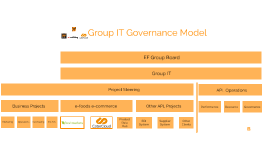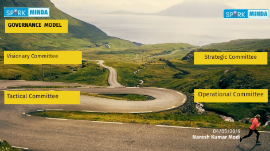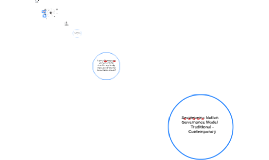GOVERNANCE MODEL
Transcript: WHAT ?? NEW GOVERNANCE MODEL Operational Decision Operational Committee Finance & IT Sourcing & Procurement Quality Excellence Committee Technology Development Committee HR & IR Committee Plant Productivity Committee MEETINGS Meetings Result MEETINGS Continued Tactical Decision Business Management Committee Vertical Meetings BV Management Meetings Executive Committee at the Business vertical level headed by BV heads. Typically comprises of Critical Functional heads like Operation head, BV Finance head etc. Review & Monitoring of Performance at the Business vertical level Plan key projects/ initiatives for the Business Take decisions which impact the business functioning. Chairperson: BV Functional Heads Chairperson: BV Heads Vertical Meetings Vertical Meetings (Functional) Chairperson: BV Functional Head (N-2) Level of Decision Making: Tactical Frequency: Fortnightly or Monthly as needed Meetings: Technical & Development, Quality & ZDI, Plant Productivity, Sourcing, PMG, HR, CSR, KAM, Marketing, Exports and Risk Management (EBITDA / ROCE) etc. Objective: Develop the organizational strategy and review overall group performance against the strategic plan for current quarter as well as long term initiatives for respective businesses, policy reviews, investment decisions, reviewing performance matrices. BV Management Meetings BV Mngmt. Meetings Chairperson: BV Head Level of Decision Making: Tactical Members: BV Functional Heads Convenor: BV Marketing Head Frequency: Monthly Meetings: MPR, LTS, Budget, Staff Meeting (MMC/EC), One to One Meeting Objective: Review business performance/ scorecard of the BV Review critical investments decisions, continuous improvement, initiatives, process change requests or project requests from Functional Committees. Strategic Committee Strategic Decision Apex Committee headed by the founder or the GCEO at the Group level. Typically comprises of different BV heads/ Group level CXOs Involves defining enterprise strategy, focus areas and potential business opportunities for all the respective Business verticals. Take major investments decisions with long-term investment Assess future preparedness of the organization. Corporate Management Committee (CMC) Corporate Management Committee(CMC) Chairperson: GCEO Level of Decision Making: Strategic Members: BV Heads, GCFO, GCMO, GCHRO, SMIT Head Convenor: As per respective Meeting platform shown below Frequency: Monthly, Quarterly, Half Yearly & Yearly as needed Meetings: LTS, Budget, EC, SMC, MPR & Risk Management Objective: Develop the organizational strategy and review overall group performance against the strategic plan for current quarter as well as long term initiatives for respective businesses, policy reviews, investment decisions, reviewing performance matrices. In-Organic Growth Management Committee In-Organic Growth Management Committee Chairperson: GCEO Members: BV Heads, GCFO, GCMO, SMIT Head Convenor: GCFO Frequency: Monthly or Quarterly as needed Meeting: Inorganic Sales Growth & Fund Generation etc. Objective: Review potential inorganic business opportunities available in the market identified by the group. Review technical & commercial feasibility of the business, assessment report, Due diligence report and business case. Track status of different opportunities being carried out and finalize business opportunity to be targeted. Account Management Committee (AMC) Account Management Committee (AMC) Chairperson: GCEO Members: BV Heads, GCFO, GCMO, SMIT Head Convenor: GCMO Frequency: Monthly Meeting: Export Growth, KAM & After market Objective: Develop account management strategy for all the business verticals of the group detailing out targeted revenue, targeted new products across the business verticals Constantly monitor and review account performance, targeted growth plans and finalize penetration strategy. Core Committee Visionary Decision We have such committee platform in various Business wherever it is mandatory as per regulations / listing requirement. In some business in order to ensure better Governance we are doing Voluntarily also. Audit Committee Remuneration Committee Grievance & Sexual Harassment Committee CSR Committee Current Status Current Status TBD TBD

















